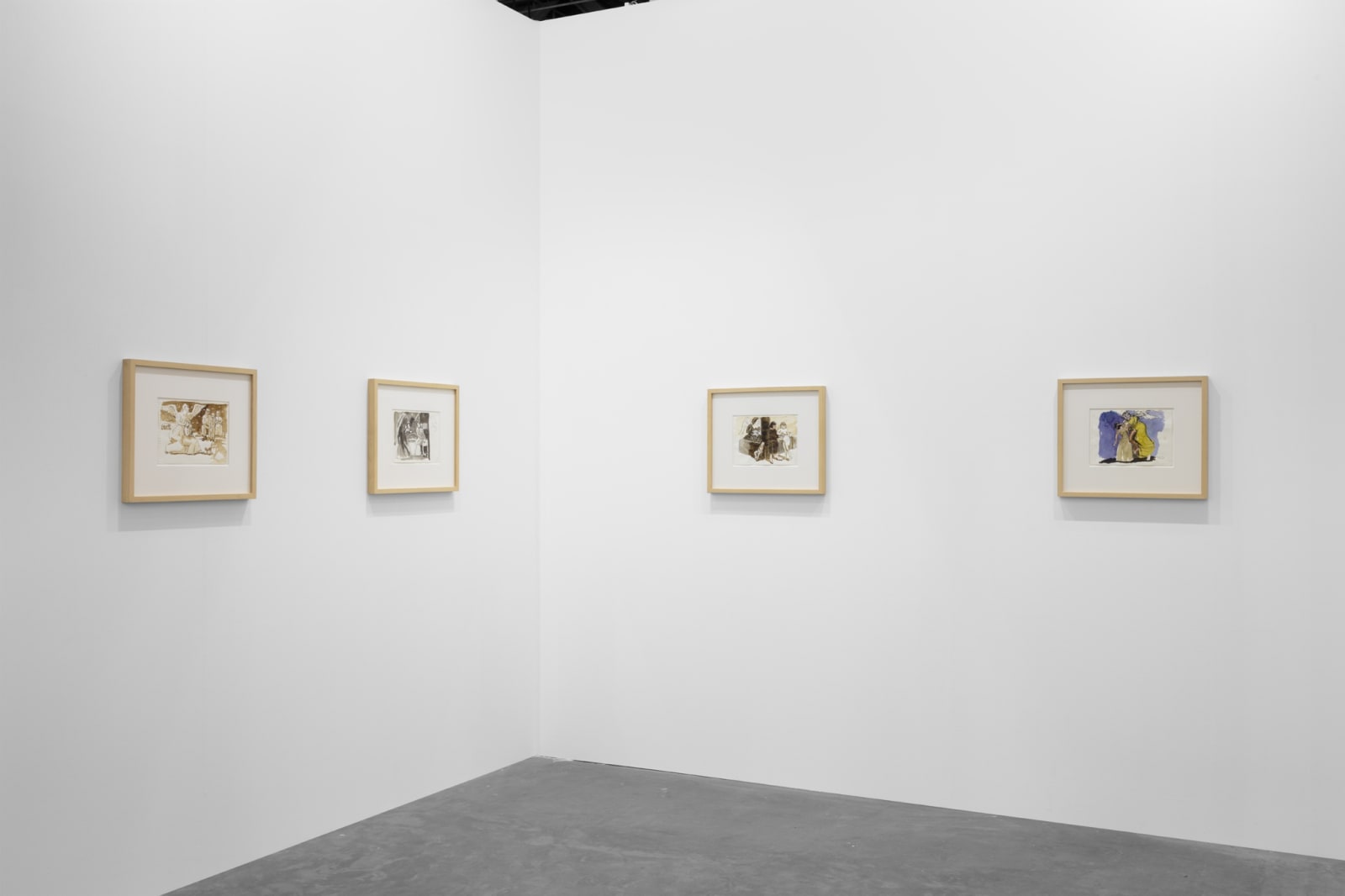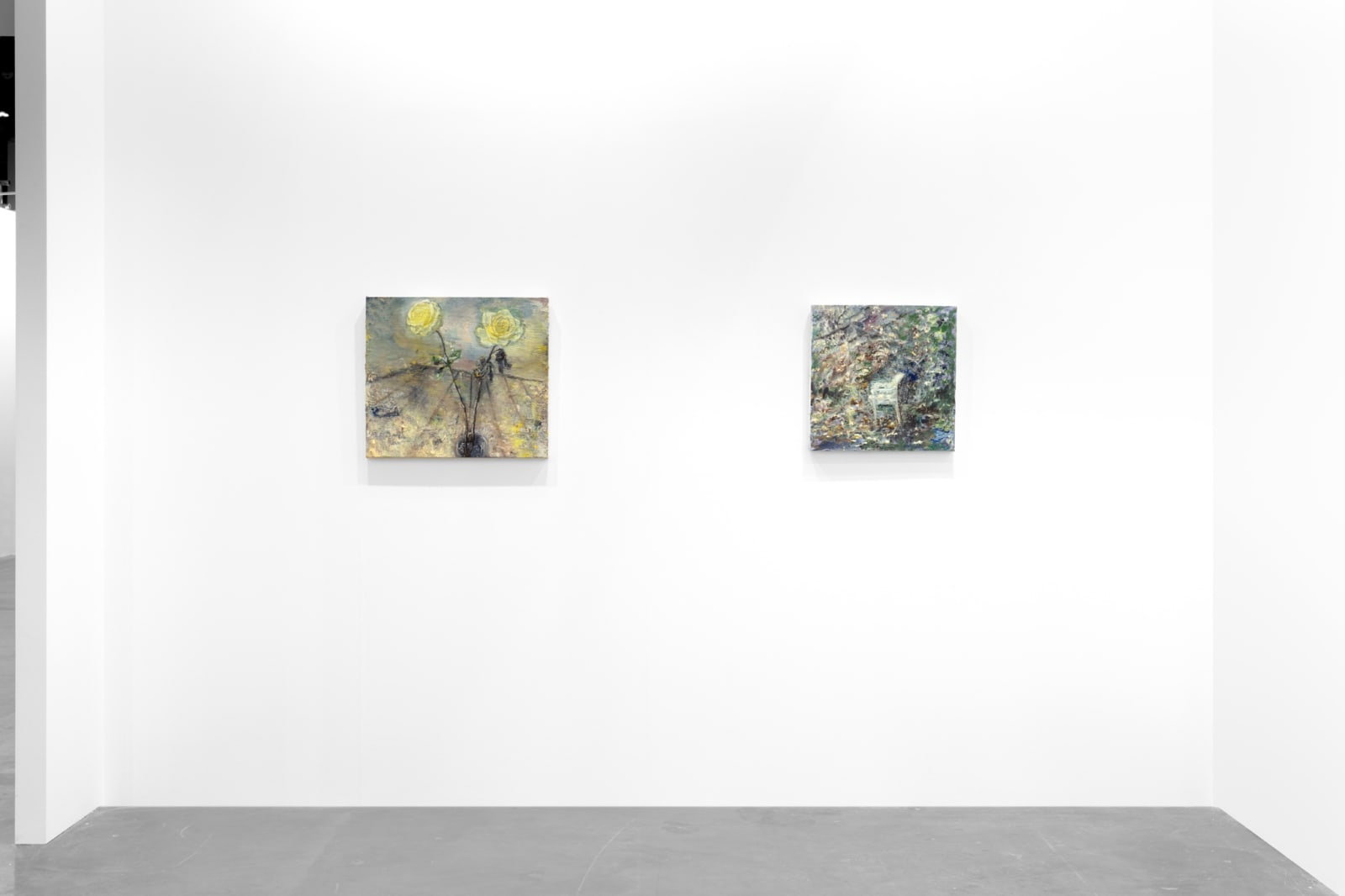ART SG 2023
Victoria Miro is delighted to participate in the inaugural edition of ART SG (Booth BD03) with works by Milton Avery, Jules de Balincourt, Hernan Bas, NS Harsha, Secundino Hernández, Chantal Joffe, Idris Khan, Alice Neel, Chris Ofili, Celia Paul, Grayson Perry, Paula Rego, Tal R, Do Ho Suh and Flora Yukhnovich.
Portrayals of family and friends, along with creative connections, offer thematic threads among the figurative works on view. One of the foremost painters of the twentieth century, Alice Neel (1900–1984) developed a unique talent for identifying particular gestures and mannerisms that reveal the singular identities of her sitters. My Mother, 1952, is one of only four paintings that Neel made of her mother, Alice Concross Hartley Neel (1868–1954). It reveals a strong empathy for the changes in body and mind that accompany old age. Just as striking is an unusual dynamic – that of the artist looking and, just as powerfully, being looked at by her subject. A second painting by Neel, completed in 1962, depictsthe photographer and author Lida Moser (a further painting by Neel of Moser, dated 1963, is in the collection of The Metropolitan Museum of Art, New York, while a photograph by Moser of Neel is in the National Portrait Gallery, Smithsonian Institution, Washington, DC). Artist Paints Artist, 1962, by the American master Milton Avery (1885–1965) is a late portrait of the artist’s wife, Sally Michel Avery, captured while working on a portrait of Avery himself. The painting is a playful depiction of their creative partnership – each being painted by the other, a self-portrait within a portrait, a double-portrait of sorts.
Artist painting artists is a theme of new large-scale works on paper by Hernan Bas, in which Bas’ protagonists engage in a variety of obsessive pursuits that, deemed strange under everyday circumstances, might be rationalised when considered as ‘conceptual art’. As ‘Conceptualists’, Bas’ characters are emboldened to indulge their passions – for example, sculpting vessels out of ice or performing funeral rites at poorly-reviewed exhibitions. Jules de Balincourt’s Sarah in the Studio, 2021, depicts a close friend of the artist and is an especially radiant example of his painting. Chantal Joffe’s subjects are often those closest to her, notably her daughter, Esme, whom she has painted from infancy, through childhood, to the young adult we see in recent works such as the monumental Esme in a Nightgown, 2022.
Flowers and gardens, and the symbolic, mythological and transformative role they play in our outer and inner lives, is another shared theme of the presentation. Harvest – Flower Eaters is a suite of works by Chris Ofili completed in watercolour, charcoal and gold leaf on paper. These works comprise two rectangular forms that read as windows on to a nocturnal world. They contain, on the left-hand side, a female head, and on the right, a male head. Facing one another, bowed and with their eyes closed, each of these holds in their mouth the stem of a flower that bursts into kaleidoscopic colour, while showers of gold dots take on a constellatory appearance against the surrounding darkness. Among works by Celia Paul, whose art stems from a deep connection to subject matter, are paintings of flowers and gardens, including Shadows on the Grass, 2021, and Chair in His Garden, 2021,symbolising memory, the passing of time and the consoling beauty of nature. Tal R’spainting of flowers, picked by the artist from around his home in the Danish countryside and presented in a vase within a closely cropped interior space, can also be considered as a memento mori, a poetic reminder that our time is fleeting.
Nature and landscape are touchstones for Idris Khan, whose painting, The cut tree, unaware of its state, 2022, completed in tones of copper blue, is among the first by the artist to incorporate both text and musical notation. Appearing as a central field, or window, of music set within a ground of text, the work expands upon enduring questions of repetition and superimposition in Khan’s art. While the sustained act of repeating and layering invites a range of corresponding contemplative, spiritual and emotional responses in the viewer, its frame-within-a-frame structure allows for an even deeper visual experience. A further formal departure is a band of unadulterated colour across the bottom of the painting that anchors the work, underscoring its rich interplay of earthly and transcendent themes.
Works by Paula Rego (1935–2022) depict episodes from the life of the Virgin Mary – subjects familiar in Christian art radically retold by Rego, that were among the most special to the artist. Completed in watercolour and ink, the works reveal Rego’s thought processes as she depicted Mary viewed from the lived experience of women – embracing the Virgin’s iconography while unseating serene and ethereal depictions from art history, finding the most pertinent parts of the story and dramatising them in ways that speak beyond the traditional narrative. Rego’s challenge in telling the story not just from the Virgin’s perspective but from the position of an embodied female figure was one that drew on her knowledge of the Old Masters, Christian art and religious texts, as well as her own experience of flesh and of faith.
Storytelling lies at the heart of NS Harsha’s practice. His compositions, which often feature figures engaging in parallel variations of a shared activity or theme, eschew linear narrative in favour of what the artist has described as ‘chanting with forms’. Festival of Recipes is a new painting featuring the repeated form of a lamp set against a vibrant red background, amongst which a series of culinary events can be seen to take place. Populated by chefs – in the traditional French chef’s uniform complete with ‘toque blanche’ – the painting on one level explores the global journey of world cuisines and the flow of influence across cultures and through time. It also marks occasions for which food, its creation and consumption, have special significance.
Do Ho Suh has long ruminated on the idea of home as both a physical structure and a lived experience, and his work gives form to ideas about migration, transience and shifting identities, blurring the boundaries of geographical distance. Made at the STPI Creative Workshop in Singapore, Rubbing/Loving, STPI, Corridor 2 - 04, 41 Robertson Quay, Singapore, 238236, 2017, is part of the artist’s celebrated Rubbing/Loving project, in which rubbings of interior spaces and everyday objects are created in a process that discloses and memorialises details of the artist’s surroundings. For Suh, these rubbing works function as symbols of memory, and in them he documents the accumulation of time and preserves his experience of living and working within spaces of special significance. They encapsulate wider ideas in his art about home and belonging, malleable space and memory, and the boundaries of identity within a shared realm.
Works on view by Grayson Perry include the large-scale tapestry Map of Truths and Beliefs, 2011, which shows places of pilgrimage, both religious and secular; contained within a central disc are many different names for the afterlife. Princess Freedom, 2017, is a cast silver sculpture that was created as a figurehead for a bicycle. ‘I think of her as a repurposed folk artefact,’ Perry wrote at the time of the work’s creation. ‘She seems to have echoes of older traditional cultures… She must be old but she seems to chime with contemporary issues on gender and equality, and she is being carried in state, honoured by a bicycle, the vehicle that gave women freedom over a century ago and that is proving central to modern urban living.’
Paintings by Secundino Hernández continue the Spanish artist’s spirited enquiry into the language, history and enduring potential of abstraction. For Hernández, painting is both a physical and cerebral activity, a conduit for intellectual and philosophical enquiry. Works on view include an example of the artist’s ‘palette painting’; created through a highly visceral accumulation of pigment, its intense impasto-like surface transforms the ‘stuff’ of painting into an undulating terrain – elemental and compelling.
Flora Yukhnovich has described her process as ‘searching for a language which sits between figuration and abstraction.’ She explains, ‘But really abstraction and figuration don’t feel separate to me. They are two different points in the same process, part of a spectrum which ranges from very loose, abstracted marks through to tightly articulated figuration. I do want the resulting paintings to remain open and ambiguous despite their figuration. The viewer has to fill in the looser areas in their mind and I hope that leads to a multiplicity of different readings.’ The presentation features a number of new works on paper by the artist.














